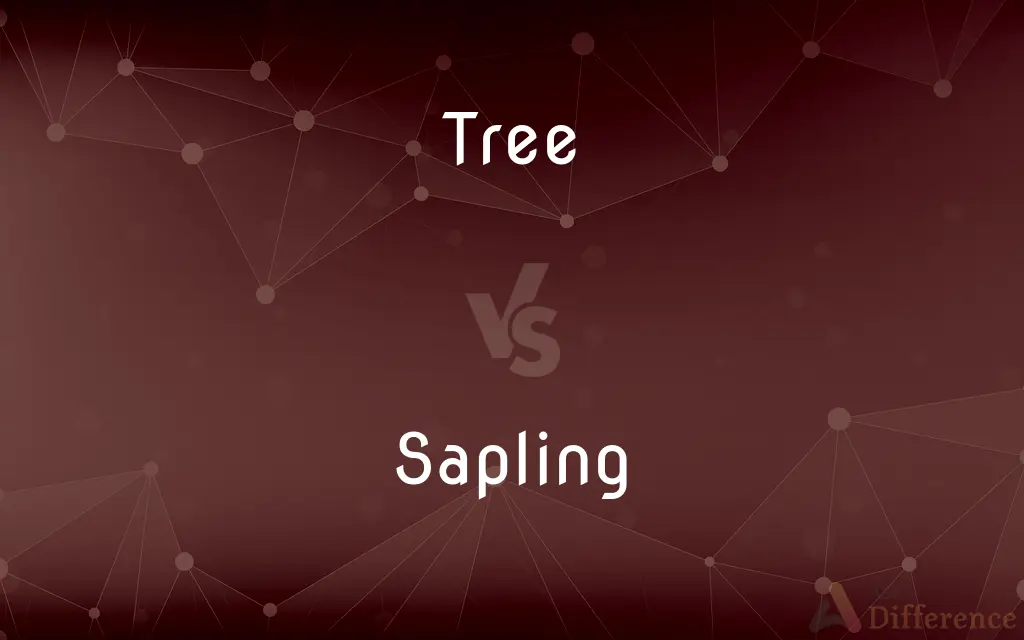Tree vs. Sapling — What's the Difference?
By Maham Liaqat & Urooj Arif — Updated on March 30, 2024
A tree is a mature plant with a woody trunk, branches, and leaves, while a sapling is a young tree, especially one that is still slender and not fully grown.

Difference Between Tree and Sapling
Table of Contents
ADVERTISEMENT
Key Differences
A tree represents a fully developed plant of its species, characterized by a significant height, a sturdy trunk, branches, and leaves or needles. It has usually reached a stage of growth where it can reproduce through flowers or cones. A sapling, on the other hand, is in the early stages of its growth. It is distinguished from a mature tree by its thin, immature trunk and smaller size, indicating that it has not yet reached its full potential in terms of height, girth, and reproductive capability.
The transition from a sapling to a tree is gradual and varies among species, influenced by factors such as environmental conditions and the specific growth habits of the plant. While a sapling is more vulnerable to environmental stresses like drought, pests, and disease due to its smaller size and less developed systems, a mature tree is generally more resilient thanks to its extensive root system and thicker bark, which offer greater protection.
Saplings require more care and nurturing to ensure their growth into healthy trees. This includes proper watering, protection from physical damage, and sometimes support stakes to keep them upright. Mature trees, while more self-sufficient, still benefit from periodic maintenance such as pruning, mulching, and inspection for pests and diseases.
Both saplings and mature trees play crucial roles in their ecosystems. Saplings represent the future of the forest, contributing to biodiversity and the regeneration of wooded areas. Mature trees provide habitat, stabilize the soil, and contribute significantly to the carbon cycle, among many other ecological benefits.
The aesthetic and functional roles of trees and saplings in landscapes also differ. Saplings can be planted to grow into desired shapes and locations, offering the chance to design future shaded or wooded areas. Mature trees, meanwhile, provide immediate benefits such as shade, privacy, and visual appeal, in addition to supporting wildlife.
ADVERTISEMENT
Comparison Chart
Definition
A mature plant with a sturdy trunk, branches, and leaves.
A young, slender tree in its early stages of growth.
Growth Stage
Mature, fully developed.
Early development, not yet fully grown.
Characteristics
Significant height, thick trunk, able to reproduce.
Thin trunk, smaller size, immature.
Vulnerability
More resilient to environmental stresses.
More vulnerable to environmental stresses.
Care Requirements
Requires periodic maintenance.
Requires more care and nurturing.
Ecological Role
Provides habitat, stabilizes soil, contributes to carbon cycle.
Contributes to biodiversity and forest regeneration.
Landscape Role
Offers immediate shade, privacy, and visual appeal.
Offers the potential for future landscape design.
Compare with Definitions
Tree
Mature plant.
The oak tree in the backyard has grown to a majestic height over the years.
Sapling
Early growth stage.
Each sapling in the nursery was tagged for monitoring its growth progress.
Tree
Thick trunk.
The ancient tree's trunk was so thick that two people couldn't wrap their arms around it.
Sapling
Needs protection.
The gardener put a fence around the sapling to protect it from deer.
Tree
Provides shade.
The large tree provided much-needed shade during the hot summer days.
Sapling
Potential for future.
The row of saplings along the driveway would one day form a welcoming canopy.
Tree
Supports wildlife.
Birds and squirrels made their homes in the dense branches of the tree.
Sapling
Young tree.
The maple sapling planted last year has already doubled in height.
Tree
Reproduction capability.
The apple tree blossoms every spring, producing fruit by fall.
Sapling
Thin trunk.
The sapling's trunk was still slender, swaying easily in the breeze.
Tree
In botany, a tree is a perennial plant with an elongated stem, or trunk, supporting branches and leaves in most species. In some usages, the definition of a tree may be narrower, including only wood plants with secondary growth, plants that are usable as lumber or plants above a specified height.
Sapling
A young tree.
Tree
A woody perennial plant, typically having a single stem or trunk growing to a considerable height and bearing lateral branches at some distance from the ground.
Sapling
A youth.
Tree
A wooden structure or part of a structure.
Sapling
A young tree, bigger than a seedling.
Tree
A thing that has a branching structure resembling that of a tree.
Sapling
(figuratively) A youngster, especially a male nearing maturity.
Tree
Force (a hunted animal) to take refuge in a tree.
Sapling
A young tree.
Tree
(of an area) planted with trees
Sparsely treed grasslands
Sapling
Young tree
Tree
A perennial woody plant having a main trunk and usually a distinct crown.
Tree
An herbaceous plant or shrub resembling a tree in form or size.
Tree
Something that resembles a tree in form, especially a diagram or arrangement that has branches showing relationships of hierarchy or lineage.
Tree
(Computers) A structure for organizing or classifying data in which every item can be traced to a single origin through a unique path.
Tree
A wooden beam, post, stake, or bar used as part of a framework or structure.
Tree
A saddletree.
Tree
A gallows.
Tree
The cross on which Jesus was crucified.
Tree
To force up a tree
Dogs treed the raccoon.
Tree
(Informal) To force into a difficult position; corner
The reporters finally treed the mayor.
Tree
To supply or cover with trees
A hillside that is treed with oaks.
Tree
A perennial woody plant, not exactly defined, but differentiated from a shrub by its larger size (typically over a few meters in height) or growth habit, usually having a single (or few) main axis or trunk unbranched for some distance above the ground and a head of branches and foliage.
Hyperion is the tallest living tree in the world.
Birds have a nest in a tree in the garden.
Tree
Any plant that is reminiscent of the above but not classified as a tree (in any botanical sense).
The banana tree
Tree
An object made from a tree trunk and having multiple hooks or storage platforms.
He had the choice of buying a scratching post or a cat tree.
Tree
A device used to hold or stretch a shoe open.
Tree
The structural frame of a saddle.
Tree
(graph theory) A connected graph with no cycles or, if the graph is finite, equivalently a connected graph with n vertices and n−1 edges.
Tree
(computing theory) A recursive data structure in which each node has zero or more nodes as children.
Tree
(graphical user interface) A display or listing of entries or elements such that there are primary and secondary entries shown, usually linked by drawn lines or by indenting to the right.
We’ll show it as a tree list.
Tree
Any structure or construct having branches representing divergence or possible choices.
Family tree; skill tree
Tree
The structure or wooden frame used in the construction of a saddle used in horse riding.
Tree
Marijuana.
Tree
(obsolete) A cross or gallows.
Tyburn tree
Tree
(chemistry) A mass of crystals, aggregated in arborescent forms, obtained by precipitation of a metal from solution.
Tree
(cartomancy) The fifth Lenormand card.
Tree
(transitive) To chase (an animal or person) up a tree.
The dog treed the cat.
Tree
(transitive) To place in a tree.
Black bears can tree their cubs for protection, but grizzly bears cannot.
Tree
(transitive) To place upon a tree; to fit with a tree; to stretch upon a tree.
To tree a boot
Tree
(intransitive) To take refuge in a tree.
Tree
Any perennial woody plant of considerable size (usually over twenty feet high) and growing with a single trunk.
Tree
Something constructed in the form of, or considered as resembling, a tree, consisting of a stem, or stock, and branches; as, a genealogical tree.
Tree
A piece of timber, or something commonly made of timber; - used in composition, as in axletree, boottree, chesstree, crosstree, whiffletree, and the like.
Tree
A cross or gallows; as Tyburn tree.
[Jesus] whom they slew and hanged on a tree.
Tree
Wood; timber.
In a great house ben not only vessels of gold and of silver but also of tree and of earth.
Tree
A mass of crystals, aggregated in arborescent forms, obtained by precipitation of a metal from solution. See Lead tree, under Lead.
Tree
To drive to a tree; to cause to ascend a tree; as, a dog trees a squirrel.
Tree
A tall perennial woody plant having a main trunk and branches forming a distinct elevated crown; includes both gymnosperms and angiosperms
Tree
A figure that branches from a single root;
Genealogical tree
Tree
English actor and theatrical producer noted for his lavish productions of Shakespeare (1853-1917)
Tree
Chase a bear up a tree with dogs and kill it
Common Curiosities
Why are saplings more vulnerable than trees?
Saplings are more vulnerable due to their less developed root systems, thinner bark, and smaller size, making them more susceptible to environmental stresses.
How long does a sapling take to become a tree?
The time it takes for a sapling to become a tree varies by species and environmental conditions, ranging from several years to decades.
How can you support the growth of a sapling?
Supporting a sapling's growth involves providing adequate water, protecting it from physical damage, ensuring it has enough space to grow, and sometimes using stakes for support.
Why might someone choose to plant a sapling instead of a mature tree?
Planting a sapling offers the opportunity to observe and nurture its growth, design future landscapes, and potentially select a species that will thrive in specific conditions.
Can saplings produce flowers or fruit?
Saplings generally do not produce flowers or fruit until they reach a more mature growth stage and have developed the necessary reproductive structures.
What distinguishes a sapling from a mature tree?
A sapling is distinguished by its young age, slender trunk, and smaller size, indicating it's in the early stages of growth, whereas a mature tree has a thick trunk, significant height, and is fully developed.
Can saplings and mature trees coexist in the same landscape?
Yes, saplings and mature trees can coexist, with mature trees providing shade and protection for saplings as they grow.
How do mature trees contribute to their ecosystems?
Mature trees provide critical habitats for wildlife, stabilize the soil with their roots, contribute to the carbon cycle, and offer shade and cooling, among other ecological benefits.
What are the benefits of planting saplings?
Planting saplings benefits the environment by contributing to biodiversity, aiding in forest regeneration, and eventually providing habitats and stabilizing the soil.
What role do trees play in urban environments?
In urban environments, trees provide shade, reduce heat island effect, improve air quality, and enhance the aesthetic appeal of streets and parks.
Share Your Discovery

Previous Comparison
One vs. First
Next Comparison
Grudging vs. BegrudgingAuthor Spotlight
Written by
Maham LiaqatCo-written by
Urooj ArifUrooj is a skilled content writer at Ask Difference, known for her exceptional ability to simplify complex topics into engaging and informative content. With a passion for research and a flair for clear, concise writing, she consistently delivers articles that resonate with our diverse audience.
















































